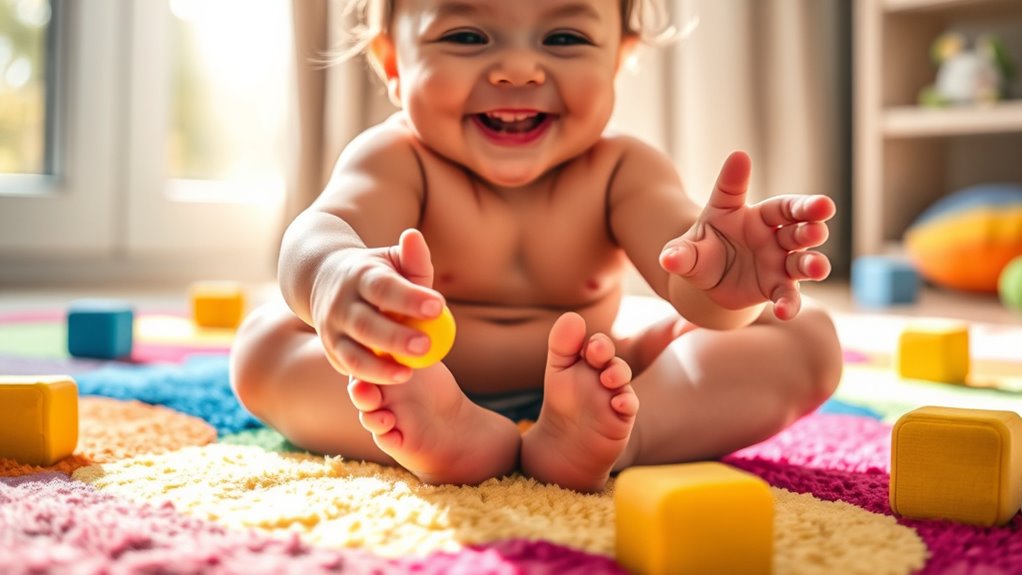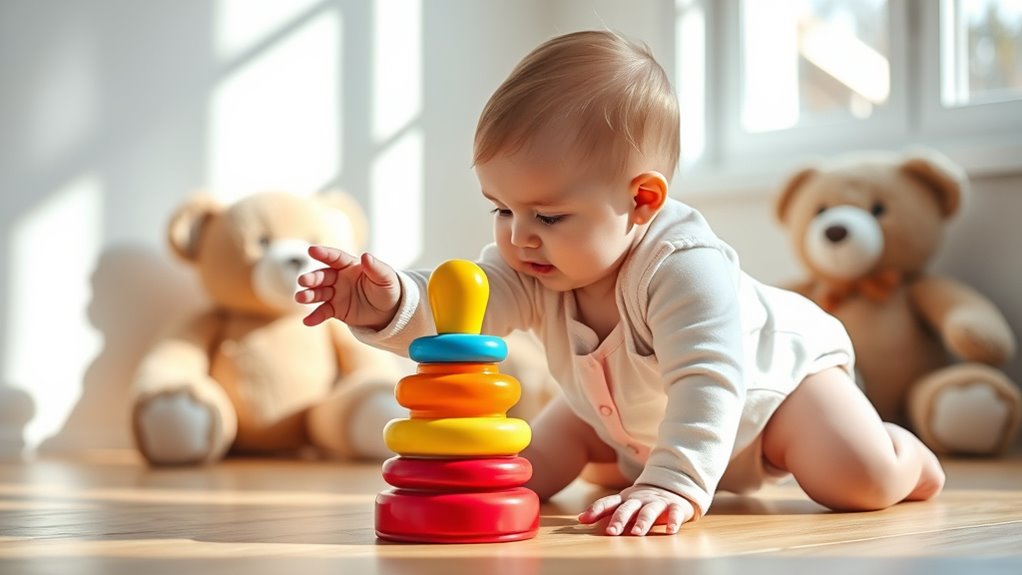Understanding your baby’s motor skills‘ early development is essential for their growth. Gross motor skills involve the use of large muscles for movements like crawling and walking, developing from head to toe. Major milestones occur from birth to 18 months, including head control, sitting, and standing. Regular physical activity, tummy time, and engaging activities boost these skills. Keep an eye on progress, as early intervention can make a difference. You’ll discover more ways to support your child’s development ahead.
Key Takeaways
- Gross motor skills development follows a head-to-toe progression, with milestones achieved at varying rates for each child.
- Key milestones include head control at 1 month, sitting without support by 6 months, and walking by 12 months.
- Encouraging tummy time and active play fosters strength and coordination essential for gross motor skills.
- Monitoring progress is crucial; delays or difficulties warrant consultation with healthcare professionals for early intervention.
- Pediatric physical therapists can provide tailored activities and support parents in promoting their baby’s motor skills development.
Understanding Gross Motor Skills

When you think about your baby’s development, you’ll notice that gross motor skills play an essential role in their ability to move and explore the world. These skills involve the large muscles in their arms, legs, and torso, enabling significant movements like crawling and walking.
Infants typically follow a head-to-toe progression in mastering these developmental milestones, starting with head control by one month and rolling over by six months. Regular physical activity, including both structured and unstructured play, is vital for enhancing these skills in infants and toddlers. Engaging in activities that promote physical activity can also contribute to their overall emotional well-being, which is crucial for their development. For instance, newborn bath tubs can provide a safe and enjoyable environment for infants to develop their motor skills during bath time. Additionally, regular outings to dog parks can inspire movement and exploration as babies observe playful dogs in action.
It’s important to remember that each child develops at their own pace; however, if you notice delays in these milestones, seeking a professional evaluation can guarantee your baby receives the support they need.
Gross Motor Skills Development by Age

When you think about your baby’s gross motor skills, you’ll notice key milestones from birth to 18 months. These skills develop in a specific sequence, from head control to walking, but keep in mind that each child grows at their own pace. Understanding these variations can help you support your baby’s unique journey. Additionally, fostering emotional resilience during this stage can significantly enhance your baby’s overall development. Encouraging environmental interactions during playtime can also promote the development of these crucial motor skills. Early exposure to physical activities can further stimulate gross motor skill growth as your baby learns to navigate their surroundings.
Milestones From Birth to 18 Months
Gross motor skills development is essential during your baby’s first 18 months, as they hit significant milestones that lay the foundation for future movement.
Here are key milestones to watch for:
- 1 Month: Your infant shows head bobbing and kicks feet while lying on their back.
- 3 Months: They can lift their head 2 to 3 inches and push up on their forearms during tummy time.
- 6 Months: Your baby sits briefly without support and rolls from back to tummy, showcasing motor skill development.
- 12 Months: Most babies pull themselves up to stand and may take their first steps, marking a key milestone in gross motor skills.
Encouraging safe body movement through activities will support your baby’s growth and development during this critical period. Engaging in educational toys that promote physical activity can further enhance their motor skills progress.
Sequence of Skill Development
As your baby grows, you’ll notice a fascinating progression in their gross motor skills development. Each stage marks important development milestones that showcase their emerging strength and coordination. Implementing strategies to foster innovation in their environment can also play a role in enhancing their learning experiences. Additionally, understanding the significance of proper nutrition can help ensure that your baby receives the essential nutrients needed for optimal growth and motor skill advancement.
| Age | Skills Developed |
|---|---|
| 1 Month | Exhibits head control; head bobs while held upright |
| 3 Months | Lifts head 2-3 inches; pushes up on forearms |
| 6 Months | Sits briefly without support; rolls from back to tummy |
| 9-12 Months | Crawls; stands independently; takes first steps |
Proper nutrition during these early months is critical for supporting overall motor skills development.
Individual Developmental Variations
Every baby develops at their own pace, and this is especially true for gross motor skills. Understanding the variations in your child’s development can help you support their growth effectively.
Here are some key points to take into account:
- Infants gain head control by 1 month, kicking their feet while on their back.
- By 3 months, they can lift their head off surfaces and push up with forearms.
- At 6 months, they sit briefly without support and roll over.
- From ages 2 to 5, kids engage in complex movements like running and climbing.
Each child’s age influences their gross motor skills, and delays may signify barriers to safe body movement.
If you’re concerned, consult a professional to improve your child’s skills, possibly through physical therapy.
Encouraging Gross Motor Development

Providing plenty of floor time is vital for your baby’s gross motor development. This time allows them to build strength and coordination, which are fundamental for their gross motor skills.
Start incorporating tummy time early to strengthen those important neck, shoulder, and trunk muscles. Engage babies in activities that encourage reaching for toys just out of reach, promoting trial and error.
Utilize both indoor and outdoor play opportunities, like crawling over obstacles or using playground equipment, to boost physical activity.
Keep an eye on your child’s progress; every child develops at their own pace. If you have concerns about missed milestones, don’t hesitate to seek a professional evaluation to guarantee your little one is on track.
Importance of Tummy Time

Why is tummy time so important for your baby’s development? Tummy time plays a vital role in enhancing motor skills for infants. It helps build strength in the neck, shoulders, arms, and trunk, essential for achieving development milestones.
Tummy time is crucial for developing your baby’s motor skills and building essential strength for future milestones.
Here are some key benefits of tummy time:
- Promotes postural control and stability
- Encourages the development of gross motor skills
- Increases engagement through colorful toys and mirrors
- Lays the groundwork for future fine motor skills
Start with short sessions on your chest, gradually shifting to a flat surface as your baby gains strength.
Activities to Promote Motor Skills

While your baby’s natural curiosity drives their exploration, engaging them in specific activities can greatly enhance their motor skills.
Providing ample floor time allows your little one to explore movement and build strength, essential for gross motor skills like crawling and rolling. Incorporating tummy time strengthens neck, shoulders, and trunk, laying the foundation for postural control.
Choose toys that encourage reaching, grasping, and manipulating to enhance fine motor skills and hand-eye coordination. Offer “just right challenges,” placing toys just out of reach to motivate practice and mastery.
Participating in structured activities, like mommy/daddy and me classes or outdoor play, provides engaging opportunities that promote gross motor skill development and body awareness, ensuring different types of motor skills development are supported effectively.
Addressing Developmental Concerns

If you notice your baby isn’t meeting expected motor skills milestones, it’s important to address your concerns promptly with a healthcare professional. Early intervention can make a significant difference in your child’s development.
Here are some signs to watch for:
- Difficulty rolling over by 6 months
- Not sitting unsupported by 9 months
- Trouble with strength and coordination
- Delays in reaching developmental milestones
A pediatric physical therapist can evaluate your baby’s motor skills and provide tailored activities to enhance their strength and coordination.
Remember, regular monitoring is essential, as variations in development are normal. Seeking help early can lead to better outcomes and support your child’s journey to developing strong motor skills.
Don’t hesitate to reach out for resources and assistance!
Frequently Asked Questions
What Are the 5 Basic Motor Skills?
The five basic motor skills are locomotion, manipulation, balancing, reaching, and grasping.
You use locomotion for movements like crawling and walking, which help you explore your environment.
Manipulation involves handling objects, such as throwing or catching.
Balancing keeps you stable, allowing you to stand on one foot.
Reaching and grasping let you engage with items around you, starting with reflexive actions that develop into intentional movements as you grow.
What Are the Early Stages of Motor Development?
Imagine a tiny seed pushing through the soil, reaching for sunlight.
In early motor development, you’ll witness similar determination. You’ll see head control at one month, followed by lifting at two months.
By three months, your little one pushes up on their forearms, gaining strength. At four months, they’ll straighten their legs and lift their chest.
By five months, rolling becomes an adventure, leading to sitting up unsupported by six months.
Each milestone’s a triumph!
What Is the Earliest Motor Skill?
The earliest motor skill you’ll notice is your baby’s ability to bob their head when held upright, typically around one month old.
This seemingly simple movement shows the beginning of neck strength and control. As you hold your little one, you might see them respond to their surroundings by moving their head.
It’s an exciting milestone, setting the stage for more complex movements as they grow and develop their motor skills.
What Can the Baby Do From 0 to 12 Months?
From the first flutter of life to the fun of their first steps, your baby’s abilities blossom remarkably!
In those twelve transformative months, you’ll see them bob their head at one month, then lift and push at three.
By six months, they can sit briefly, and by nine, they’ll crawl and pull up.
As the year wraps up, watch them stand with support, ready to take those exciting first wobbly steps!
Conclusion
As you watch your baby wriggle and roll, remember that each small movement is a stepping stone to greater adventures. With every kick and stretch, they’re building strength and confidence. Embrace tummy time like a cozy blanket, wrapping them in comfort as they explore their world. By encouraging play and movement, you’re nurturing their journey into a confident little explorer. Trust the process, and soon you’ll see them crawling, standing, and dancing through life’s beautiful rhythms.









